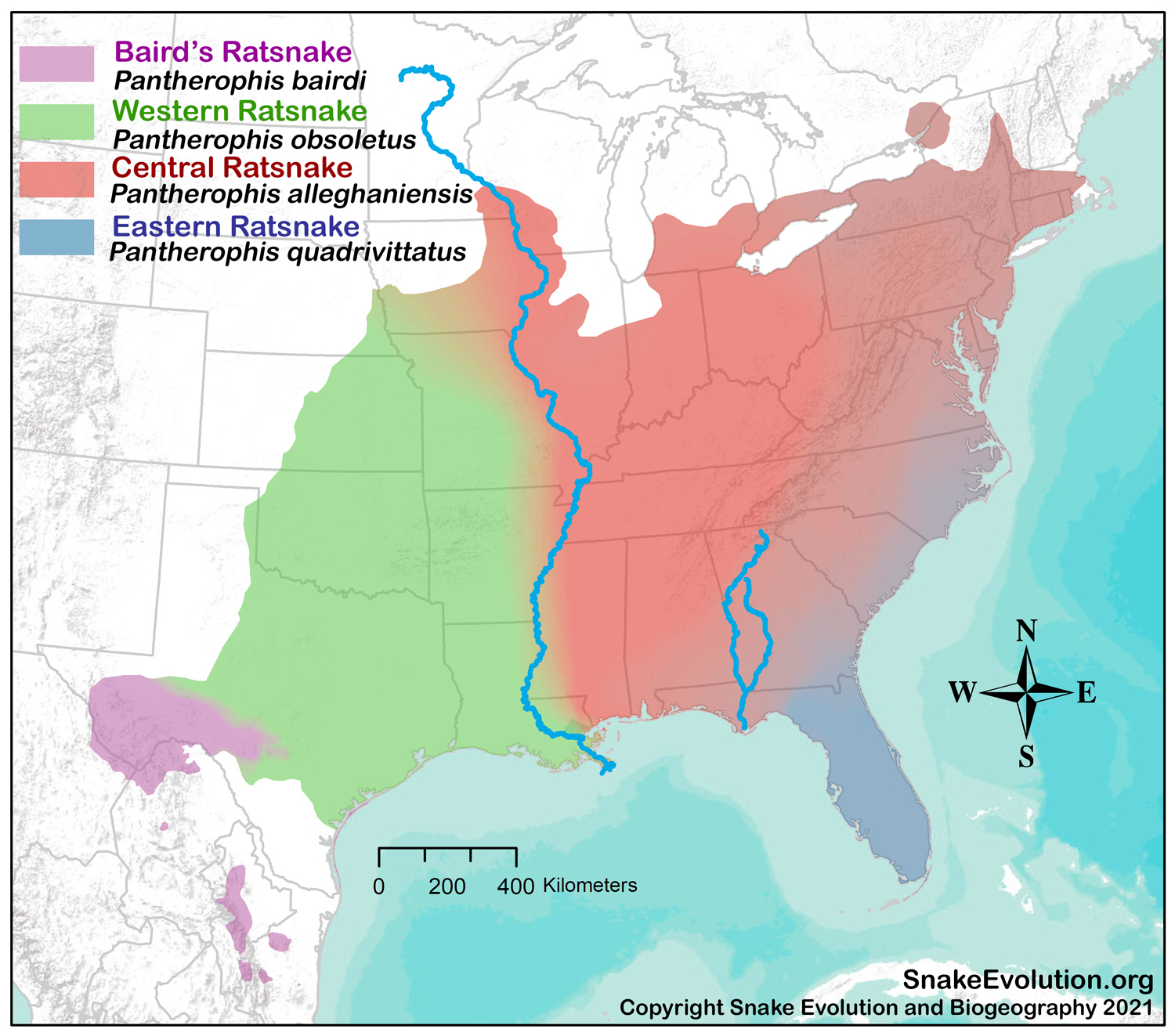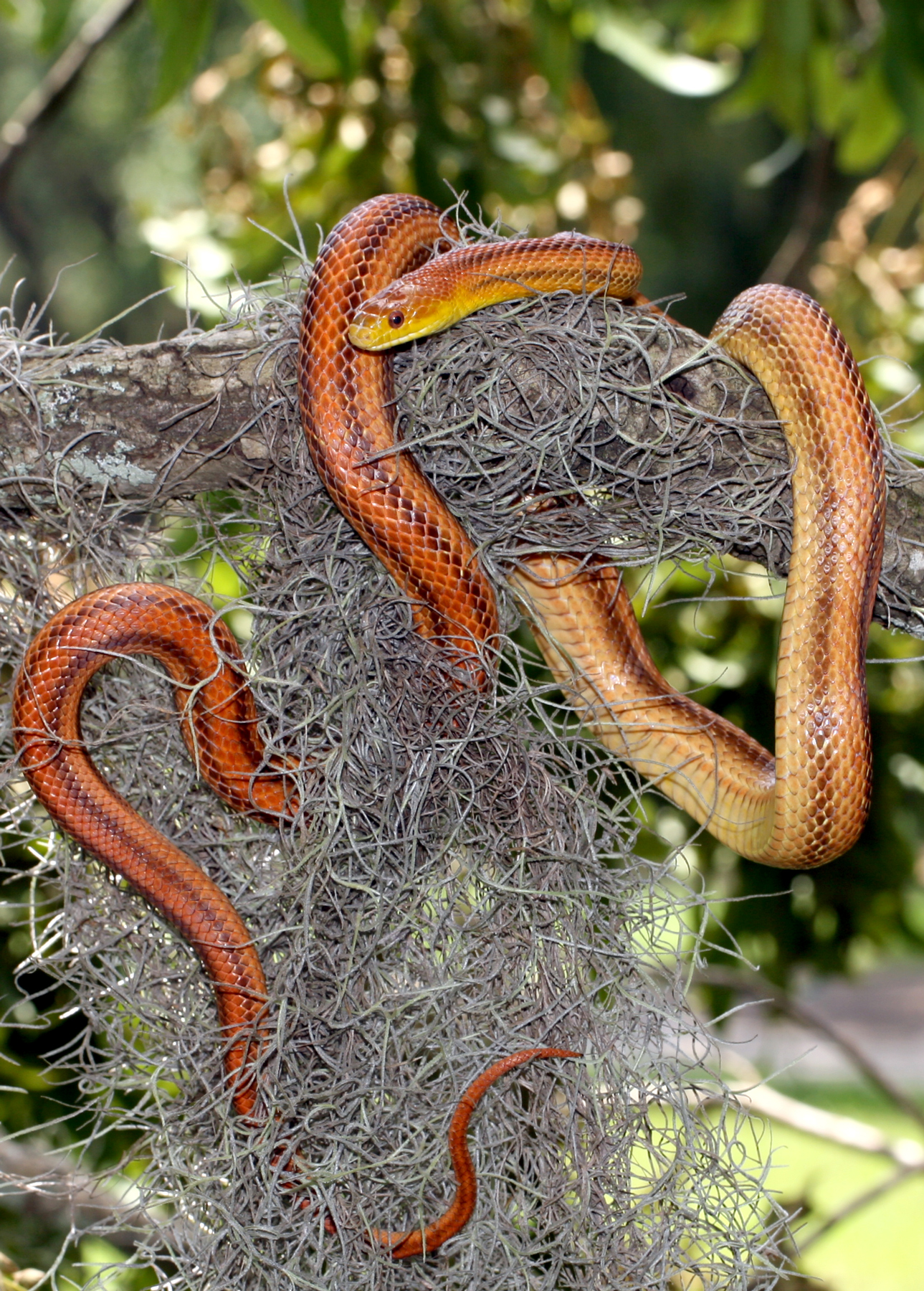Ratsnakes Pantherophis obsoletus complex
The Pantherophis obsoletus species complex is comprised of four species of very diversely patterned ratsnakes in Eastern North America. Even within species, color pattern is variable and tied to the environments in which the individuals are found. The map below shows the approximate extent of the range of the four currently recognized species. Click on each species to learn more about it, or scroll down to learn about the historical biogeography of this species complex, how research into this complex expands our understanding of snake evolution, how these species are affected by changing climate and what you can do to help understand and protect them far into the future.

Where are the "black ratsnakes" and why is this account different from older sources?
"Black Ratsnake is a common name for a color pattern shared by three different species of *Pantherophis* ratsnake across the northern portion of their range. The black ratsnake species complex, formerly *Elaphe obsoleta*, underwent revision in 2001-2002 from multiple authors and received three main changes from 2000 to now. First, the complex was delimited in [Burbrink 2001] based on what were then modern molecular methods, where three distinct lineages were uncovered that did not reflect previous subspecies designations. Each of the three geographically partitioned taxa were elevated to full species status, and subspecies were discarded. The polytypic color patterns in these species are most likely under strong selection by the local environment and don't reflect evolutionary history. Where species intersect and habitat converges, color pattern also converges, leaving these species nearly morphologically indistinguishable to the naked eye.
Second, using *Elaphe* as a genus name wasn't the best way to reflect phylogenetic history, so the genus *Pantherophis* was adopted for new world ratsnakes in [Utiger 2002]. Remember, species names are hypotheses that are tested and revised. While the analyses published in 2001 are strong and results are geographically similar in other taxa, these species were investigated further using genomic data, and in 2020 the authors [released an update], clarifying ranges, filling in grey zones and confirming three distinct species.
Third, clarity in range and type specimens necessitated the need to fix lineage names in line with taxonomic rules called the 'principle of priority'. The four currently accepted species in this complex as of October 2021 are Baird's Ratsnake Pantherophis bairdi, Western RatsnakePantherophis obsoletus, Central RatsnakePantherophis alleghaniensisand Eastern RatsnakePantherophis quadrivittatus
The experts on this group offer this summary [from their 2021 paper]): "For the ratsnakes in particular, given the overtly chaotic and unsubstantiated basis of their taxonomy in the late 1990s, Burbrink et al. (2000) endeavored to test this taxonomic hypothesis (sensu Gaston and Mound 1993). This also provided an empirical observation of geographic genetic variation (then an unknown quantity) as an act of phylogenetic natural history (sensu Lamichhaney et al. 2019). Their analyses rejected the existing taxonomy as incompatible with the estimated evolutionary history of the group, ending a paradigm that was at least 48 years old from Dowling (1952) with respect to the non-historical subspecies definitions. Subsequently, Burbrink (2001) conducted an explicit taxonomic revision based on both mitochondrial and multivariate morphological analyses in an integrative taxonomy. The limitations of these data (scale counts, mensural measurements, and maternally inherited DNA) produced a zone of potential taxonomic uncertainty, while nonetheless allowing for significant statistical phenotypic discrimination between the geographic genetic lineages. Thus, based on the best possible evidence and interpretation at the time, the now-falsified historical taxonomic arrangement of subspecies definitions was replaced with an explicitly phylogenetic, lineage-based species-level taxonomy derived from the estimated evolutionary history of the group. The persistence of some remaining uncertainty is a natural and expected outcome in all scientific investigations, as we can never have complete data or perfect knowledge of a system. Twenty years later, Burbrink et al. (2021) more than tripled the number of individuals sampled, increased the number of loci used by 2491 times, and thus clarified the remaining fuzziness associated with the potential zone of taxonomic uncertainty. They revealed this uncertainty to be a complex hybrid zone with varying degrees of admixture. This had the additional effect, as described above, of redefining the allocation of type localities and valid names, and thus the taxonomic proposal here represents the best present-day resolution of nomenclature in the group, in accordance with our understanding of its evolutionary history. As science progresses, even this may change in the future with new whole genome datasets or interpretations of phylogeographic lineage formation and phylogenetic species concepts. These conclusions may be unsettling to those that wish to retain taxonomies generated from data and assumptions about species and subspecies made in the 19th and 20th century. However, we question the social and scientific utility of any insistence on recognizing clearly falsified, non-historical arrangements based solely on the burden of heritage in taxonomic inertia (see Pyron and Burbrink 2009b)."
Links for Biologists and Educators:
Shapefiles for range and habitat [.asc xx mb]
Original Research on Ratsnake Phylogeography [Online HTML Full Text]
Slo










